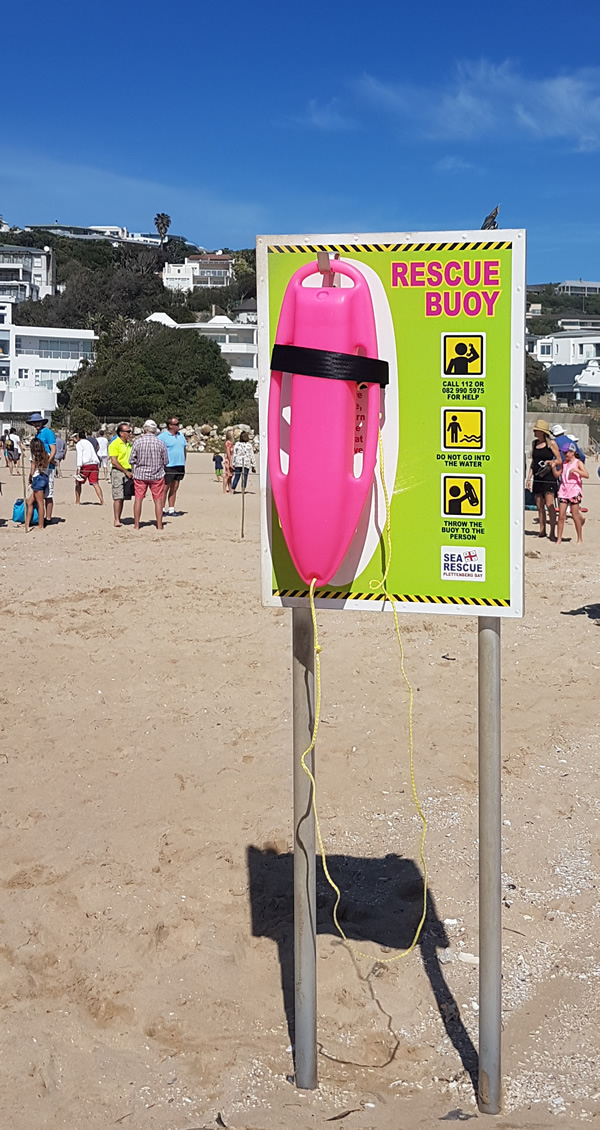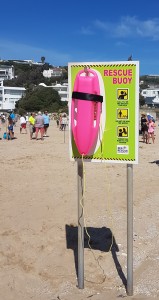
NSRI installing Pink Torpedo Buoys at beaches in campaign to address drownings
The National Sea Rescue Institute (NSRI) has launched a national emergency floatation campaign using Pink Torpedo buoys.
“These brightly coloured rescue devises, chosen because they are easily visible in water are being placed at high risk areas, especially where there are rip currents and no lifeguards on duty,” says NSRI spokesperson, Craig Lambinon.
“The sign, which can be attached to a pole or drilled into a wall, holds a Pink Torpedo Buoy and by using simple graphics the NSRI explains that it should be thrown to a person in difficulty and that an untrained person should not enter the water to help or try and rescue someone.”
He said that the Pink Torpedo Buoy project needs the support of the community in which they are placed.
“If the community takes ownership of the project the pink buoys will only be removed from their holder in an emergency and will be replaced after use.
“The idea behind the project is to get emergency flotation to someone who is in danger of drowning as fast as possible while calling for professional help. Graphics on the sign advise that the buoy should be thrown to someone in distress, that an untrained rescuer should not get into the water to try and rescue someone, and provides two telephone numbers to dial for help,” Lambinon described.
“Each Pink Torpedo Buoy sign also has a location number so that bystanders can tell Sea Rescue volunteers exactly where they are. One hundred Pink Torpedo Buoys have been sponsored and are currently being deployed at Plettenberg Bay, Wilderness, Jeffreys Bay and Melkbosstrand.”
Ideally every piece of water that is used for recreation should have an emergency floatation device. The cost of the Pink Torpedo Buoy and the sign is R1400.
This excludes a pole and putting it in place. You can donate to this project here www.nsri.org.za/ways-to-support-us
Here are some general safety tips to bear in mind this summer:
1. Swim at beaches were and when lifeguards are on duty.
Lifeguards are on duty at selected beaches between 10 and 6pm on weekends and during the week in summer school holidays. Listen to their advice and talk to them about safety on the beach that you are visiting. They are the experts on that beach. If lifeguards are not on duty do not swim.
2. Swim between the lifeguard’s flags.
Teach children that if they swim between the lifeguards flags the lifeguards will be watching them and can help if there is a problem. Lifeguards watch swimmers very carefully between the flags – just wave an arm if you need help.
3. Don’t Drink and Drown
Alcohol and water do not mix. Never drink alcohol and then go to swim.
4. Don’t swim alone. Always swim with a buddy.
If you are with a buddy while swimming there is someone who can call for help if you need it and you can’t wave to the lifeguards or call for help yourself.
5. Adult supervision and barriers to water are vital.
Adults who are supervising children in or near water must be able to swim. This is vital if it is at a water body that does not have lifeguards on duty. It is extremely dangerous to get into the water to rescue someone so rather throw something that floats to the person in difficulty and call for help (112 from a cell phone and check for the nearest Sea Rescue station telephone number before you visit a beach – put that number into your cell phone). Children should not be able to get through or over barriers such as pool fences to water.
6. Know how to survive rip currents.
If you swim between the lifeguard flags they will make sure that you are safe and well away from rip currents. If for some reason this is not possible do not swim. Educate yourself about rip currents, there is plenty of educational material here www.nsri.org.za/2017/01/beware-of-rip-currents including videos of what rip currents look like.
7. Don’t attempt a rescue yourself.
Call a lifeguard or the NSRI by dialling 112 from your cell phone for help. If you see someone in difficulty call a lifeguard at once or dial the nearest Sea Rescue station from your cell phone. You should put this number into your phone before you go to the beach – get the emergency numbers for NSRI here www.nsri.org.za/emergency-numbers or you can Google for the closest NSRI station emergency number. 112 is a good emergency number – for any emergency – to dial from your cell phone. After calling for help try and throw something that floats to the person in difficulty. A ball, a foam board and so on.
8.Do not let children use floating objects, toys or tire tubes at the beach or on dams.
You can very quickly get blown away from the shore and as much fun as tubes and Styrofoam are it is easy to fall off them. If a child can’t swim and falls off in deep water they will drown.
9. Do not be distracted by your cell phone or social media.
While you are looking after children in or near water you need to focus on them and nothing else. Adults who are supervising children should not be distracted or use their cell phone. It is not possible to concentrate on children in the water and be on your phone at the same time.
10. Visit a beach that has lifeguards on duty – there is a reason that we have said this twice!
Please remember that drowning is completely silent. Someone who is drowning will not shout for help. They will be vertical in the water (like they are trying to stand or climb stairs) and they will then silently slip under the water. Listening for children (or adults) in difficulty in the water is not good enough, you must be watching them very carefully. Make sure that they are not getting in too deep or being moved by currents away from a safe area.
Also, be aware in the drought of storing water without safe covers and make sure that they are behind barriers to small children. Especially children under 4 years of age. A small child does not have the strength to lift themselves out of a bucket of water and if they fall into a bucket they will drown. At home make sure that your pool has a child safe pool cover or net and an approved fence that has a double locking gate and can’t be climbed by small children.
Image: A Pink Torpedo Buoy at Jeffrey’s Bay. Picture by Rieghard Janse Van Rensburg
NSRI National Drowning Prevention Manager – Andrew Ingram: +27 82 9905977.













